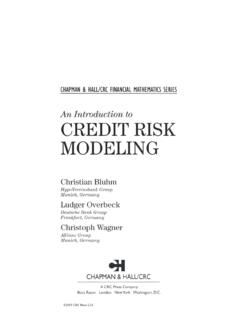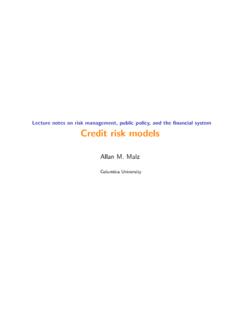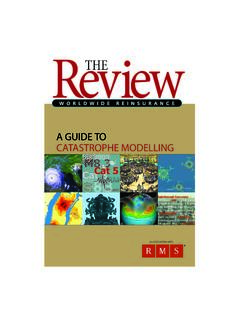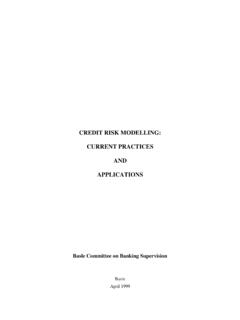Transcription of A general methodology for modeling LGD - RMA U
1 C A P I TA L M A N A G E M E N T. A general methodology for modeling Loss Given Default by Nadeem A. Siddiqi and Meiqing Zhang H. ere's an LGD how to a step-by-step methodology for developing a reliable econometric model for Basel-compli- ant loss given default. Each step defining LGD, convert- ing raw data for use in standard regression techniques, and selecting and defining variables requires great care if the final product is to be a totally transparent, multifactor statistical model incorporating data at the loan level, the firm level, and the macroeconomic level. T. raditional loss given default (LGD) calcula- standing balance at default and authorized balance at tions are typically estimated by looking at default are on the border of significance.
2 Historical averages, usually segregated by The next section discusses the dependent vari- collateral type and seniority type. This articles offers able (LGD) definition as well as the econometric an approach that regresses LGD on several inde- procedure to transform it from its original beta distri- pendent variables with the goal of understanding bution to a normal distribution suitable for ordinary which factors drive bank loan losses and, further, the least squares (OLS) regressions. Following that we amount of losses to expect when loans do default. discuss the independent variables used in the analy- The model presented here incorporates macroeco- sis as well as their rationale.
3 The fourth section dis- nomic, firm-specific, and loan-specific information. cusses the final model and its results. Conclusions While the exact model presented here won't fit are drawn at the end to summarize the results and every bank, the approach and methodology may help approach. in estimating other LGD models. Our model results show that several variables are Dependent Variable both statistically and economically significant in We defined LGD, the loss given default rate, as modeling LGD. They include total debt over capital, the percentage of the charge-off (net of charge-off profit margin, revenue, ratio of current liabilities over recovery) over outstanding balance at default for total liabilities, risk rating at default, industry type, each defaulted loan.
4 The definition of LGD used GDP growth rate, and tightness of the loan requires careful attention since there are at least two covenants. Some variables, such as collateral type ways of defining LGD. Theoretically, loss derived and seniority, appear to be insignificant, while out- from net charge-off should be the same as that 2004 by RMA. Nadeem Siddiqi and Meiqing Zhang are senior consultants with the Credit Analytics and Data Management Group of the Financial Services business unit of BearingPoint, Inc. BearingPoint provides business and technology strategy, systems design, architecture, applications implementation, network infrastructure, systems integration, and managed services.
5 All views and opinions expressed here are those of the authors and do not necessarily reflect those of BearingPoint, Inc. 92 The RMA Journal May 2004. A general methodology for modeling Loss Given Default derived from the remaining balance of total cash out- Independent Variables flows and cash inflows after default. Specifically, Based on our experience, our reading of the litera- ture and empirical analysis, we tried various explana- Loss derived from net charge-off = charge-off - charge-off recovery tory factors in the model. These include variables Loss derived from cash flows = total cash outflows - total cash inflows capturing loan-specific information, firm-specific While the loss data derived from these two information, and macroeconomic information, as fol- sources should be the same, empirically some dis- lows: crepancies are noticed and require deeper investiga- Loan-specific information.
6 Tion to ensure consistency with other definitions Ratio of collateral value at default / outstanding at default. used in the overall Basel-compliant risk analysis Ratio of collateral value at one year before default / out- modeling framework within the bank, especially standing at default. with the definitions used in any other data, internal Outstanding balance at default / one year before default. or external. Since the loss data is used to arrive at Authorized balance at default. the independent variable LGD, such discrepancies Risk rating at default. might significantly affect the modeling results.
7 Risk rating at one year before default. As a normally distributed variable is required to Collateral type. utilize OLS regression techniques, we transform Facility type. LGD from its original underlying beta distribution Covenant structure. to a normal distribution. This is done in two steps. Seniority. 1. First we calculate the and parameters from the Firm-specific information. underlying beta distribution as follows. Leverage I: (total assets - net worth) / net worth. Define Leverage II: total debt / capital at default. LGD = (Charge-off - charge-off recovery) / Outstanding balance at default Operating income/sales at default.
8 : The beta distribution's center parameter and can be derived from Current liability/total liability at one year before default. equations below Firm size: revenue, total assets, net worth. : The beta distribution's shape parameter and can be derived from Industry type. equations below Min: Minimum of all cases general economy information. Max: Maximum of all cases GDP quarterly growth rate one year before default. and are then derived from the following equations: The collateral ratio, defined as a ratio of collater- (Max - ) al value at default (or one year before default) to the . 1. Max Max 2 outstanding balance at default (or one year before default), is used as one explanatory variable.
9 This Max estimates a bank loan's recovery rate as a function of 1. its corresponding collateral ratio where collateral is involved. As empirically used in many credit risk where , 2 are population mean and variance models, the expected negative relationship between respectively. the recovery rate and the collateral rate proves useful in estimating recovery rates, in setting sufficient col- 2. We then transform LGD from a beta to a normal lateral requirements, and in pricing debt with sto- distribution suitable for use in OLS regressions, chastic collateral values. using the definitions of and as calculated above.
10 Each loan was assigned a risk rating based on the NLGD = Normal (LGD, , ) bank's internal risk-rating model. The ratings range .. Max and .. Max from 10 to 100; the higher the rating, the greater the risk of the loan. ( )2 (1 ) We assigned dummy variables for the facility type based on the total numbers of each facility type 93. A general methodology for modeling Loss Given Default in our dataset. For some facility types, such as com- Table 1. mitted revolving loans, committed term loans, or Best-fitting LGD Regression Results fixed term loans, there are quite a few data points in Variable Coefficient Sign our dataset.









